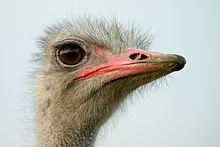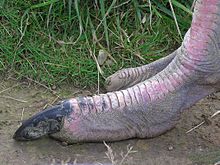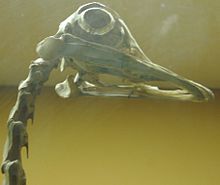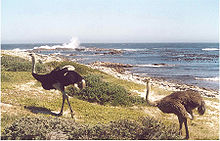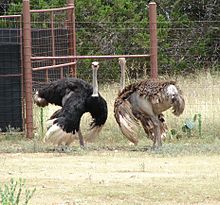- Ostrich
-
For other uses, see Ostrich (disambiguation).
Ostrich
Temporal range: pleistocene–present Pleistocene to Recent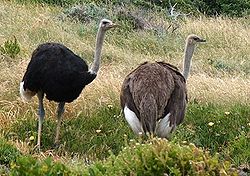
Male (left) and female (right) Conservation status Scientific classification Kingdom: Animalia Phylum: Chordata Subphylum: Vertebrata Class: Aves Superorder: Paleognathae Order: Struthioniformes Family: Struthionidae Genus: Struthio Species: S. camelus Binomial name Struthio camelus
Linnaeus, 1758[2]Subspecies S. c. australus Gurney, 1868[2]
Southern Ostrich
S. c. camelus Linnaeus, 1758[2]
North African Ostrich
S. c. massaicus Neumann, 1898[2]
Masai Ostrich
†S. c. syriacus Rothschild, 1919[2]
Arabian Ostrich
S. c. molybdophanes Reichenow, 1883[2]
Somali Ostrich
Distribution The Ostrich is one or two species of large flightless birds native to Africa, the only living member(s) of the genus Struthio. Some analyses indicate that the Somali Ostrich may be better considered a full species apart from the Common Ostrich, but most taxonomists consider it to be a subspecies.
Ostriches share the order Struthioniformes with the kiwis, emus, and other ratites. It is distinctive in its appearance, with a long neck and legs and the ability to run at maximum speeds of about 97.5 kilometres per hour (60.6 mph), the top land speed of any bird.[3][4] The Ostrich is the largest living species of bird and lays the largest egg of any living bird (extinct elephant birds of Madagascar and the giant moa of New Zealand did lay larger eggs).
The diet of Ostriches mainly consists of plant matter, though it also eats invertebrates. It lives in nomadic groups which contain between five and fifty birds. When threatened, the Ostrich will either hide itself by lying flat against the ground, or will run away. If cornered, it can attack with a kick from its powerful legs. Mating patterns differ by geographical region, but territorial males fight for a harem of two to seven females. These fights usually last just minutes, but they can easily cause death through slamming their heads into opponents.
The Ostrich is farmed around the world, particularly for its feathers, which are decorative and are also used as feather dusters. Its skin is used for leather products[5] and its meat marketed commercially.[6]
Contents
Description
Ostriches usually weigh from 63 to 130 kilograms (140–290 lb),[7][8] with exceptional male Ostriches weighing up to 156.8 kilograms (346 lb).[8] The feathers of adult males are mostly black, with white primaries and a white tail. However, the tail of one subspecies is buff. Females and young males are greyish-brown and white. The head and neck of both male and female Ostriches is nearly bare, with a thin layer of down.[7][9] The skin of the females neck and thighs is pinkish gray,[9] while the male's is blue-gray, gray or pink dependent on subspecies.
The long neck and legs keep their head 1.8 to 2.75 metres (6 to 9 ft) above the ground, and their eyes are said to be the largest of any land vertebrate – 50 millimetres (2.0 in) in diameter;[10] they can therefore perceive predators at a great distance. The eyes are shaded from sun light falling from above.[11][12]
Their skin varies in colour depending on the sub-species. The strong legs of the Ostrich are unfeathered and show bare skin, with the tarsus (the lowest upright part of the leg) being covered in scales – red in the male, black in the female.[8] The bird has just two toes on each foot (most birds have four), with the nail on the larger, inner toe resembling a hoof. The outer toe has no nail.[13] The reduced number of toes is an adaptation that appears to aid in running. Ostriches can run at over 70 kilometres per hour (43 mph) for up to 30 minutes.[citation needed] The wings reach a span of about 2 metres (7 ft)[14] and are used in mating displays and to shade chicks. The feathers lack the tiny hooks that lock together the smooth external feathers of flying birds, and so are soft and fluffy and serve as insulation. They have 50-60 tail feathers, and their wings have 16 primary, four alular and 20-23 secondary feathers.[8] The Ostrich's sternum is flat, lacking the keel to which wing muscles attach in flying birds.[15] The beak is flat and broad, with a rounded tip.[7] Like all ratites, the Ostrich has no crop,[16] and it also lacks a gallbladder.[17] They have three stomachs, and the caecum is 71 centimetres (28 in) long. Unlike all other living birds, the Ostrich secretes urine separately from faeces.[18] Contrary to all other birds who store the urine and faeces combined in the coprodeum, they store the faeces in the terminal rectum.[18] They also have unique pubic bones that are fused to hold their gut. Unlike most birds the males have a copulatory organ, which is retractable and 8 inches (20 cm) long. Their palate differs from other ratites in that the sphenoid and palatal bones are unconnected.[8]
At sexual maturity (two to four years), male Ostriches can be from 1.8 to 2.8 metres (5 ft 11 in to 9 ft 2 in) in height,[8] while female Ostriches range from 1.7 to 2 metres (5 ft 7 in to 6 ft 7 in). During the first year of life, chicks grow about 25 centimetres (10 in) per month. At one year of age, Ostriches weigh around 45 kilograms (100 lb). Their lifespan is up to 40 or 45 years.
A female ostrich can determine her own eggs amongst others in a communal nest.[citation needed]
Taxonomy
The Ostrich was originally described by Linnaeus in his 18th-century work, Systema Naturae under its current binomial name.[19] Its scientific name is derived from Latin, struthio meaning "Ostrich" and camelus meaning "camel", alluding to its dry habitat.[20]
The Ostrich belongs to the ratite order Struthioniformes. Other members include rheas, emus, cassowaries, moa, kiwi and the largest bird ever, the now-extinct Elephant Bird (Aepyornis). However, the classification of the ratites as a single order has always been questioned, with the alternative classification restricting the Struthioniformes to the Ostrich lineage and elevating the other groups. Presently, molecular evidence is equivocal[citation needed] while paleobiogeographical and paleontological considerations are slightly in favor of the multi-order arrangement.
Subspecies
Five subspecies are recognized:
- 'Common Ostrich (S. struthio) complex':
- S. c. australis, Southern Ostrich, southern Africa. It is found south of the Zambezi and Cunene rivers. It was once farmed for its feathers in the Little Karoo area of Cape Province.[21]
- S. c. camelus, North African Ostrich, or Red-necked Ostrich, North Africa. Historically it was the most widespread subspecies, ranging from Ethiopia and Sudan in the east throughout the Sahel[22] to Senegal and Mauritania in the west, and north to Egypt and southern Morocco, respectively. It has now disappeared from large parts of this range,[23] and it only remains in 6 of the 18 countries where it originally occurred, leading some to consider it Critically Endangered.[24] It is the largest subspecies, at 2.74 metres (9.0 ft) in height and up to 154 kilograms (340 lb) in weight.[25] The neck is pinkish-red, the plumage of males is black and white, and the plumage of females is grey.[25]
- S. c. massaicus, Masai Ostrich, East Africa. It has some small feathers on its head, and its neck and thighs are pink. During the mating season, the male's neck and thighs become brighter. Their range is essentially limited to southern Kenya and eastern Tanzania[22] and Ethiopia and parts of Southern Somalia.[25]
- S. c. syriacus, Arabian Ostrich or Middle Eastern Ostrich, Middle East. Was formerly very common in the Arabian Peninsula, Syria,[22] and Iraq; it became extinct around 1966.
- S. c. molybdophanes, Somali Ostrich, southern Ethiopia, northeastern Kenya, and Somalia.[22] The neck and thighs are grey-blue, and during the mating season, the male's neck and thighs become brighter and bluer. The females are more brown than those of other subspecies.[25] It generally lives in pairs or alone, rather than in flocks. Its range overlaps with S. c. massaicus in northeastern Kenya.[25]
Some analyses indicate that the Somali Ostrich may be better considered a full species, but there is no consensus among experts about this. The Tree of Life Project and IOC recognize it as a different species, but The Clements Checklist of Birds of the World, Howard and Moore Complete Checklist of the Birds of the World and BirdLife International do not. As of 2010 BirdLife International is reviewing the proposed split.[26] Mitochondrial DNA haplotype comparisons suggest that it diverged from the other Ostriches not quite four mya due to formation of the Great Rift Valley. Hybridization with the subspecies that evolved southwestwards of its range, S. c. massaicus, has apparently been prevented from occurring on a significant scale by ecological separation, the Somali Ostrich preferring bushland where it browses middle-height vegetation for food while the Masai Ostrich is, like the other subspecies, a grazing bird of the open savanna and miombo habitat.[27]
The population from Río de Oro was once separated as Struthio camelus spatzi because its eggshell pores were shaped like a teardrop and not round. However, as there is considerable variation of this character and there were no other differences between these birds and adjacent populations of S. c. camelus, the separation is no longer considered valid.[28] This population disappeared in the latter half of the 20th century. There were 19th century reports of the existence of small Ostriches in North Africa; these are referred to as Levaillant's Ostrich (Struthio bidactylus) but remain a hypothetical form not supported by material evidence.[29]
Evolution
The earliest fossil of Ostrich-like birds is the Palaeotis living near the Asiatic steppes,[8] from the Middle Eocene, a middle-sized flightless bird that was originally believed to be a bustard. Apart from this enigmatic bird, the fossil record of the Ostriches continues with several species of the modern genus Struthio which are known from the Early Miocene onwards. While the relationship of the African species is comparatively straightforward, a large number of Asian species of Ostrich have been described from fragmentary remains, and their interrelationships and how they relate to the African Ostriches is confusing. In China, Ostriches are known to have become extinct only around or even after the end of the last ice age; images of Ostriches have been found there on prehistoric pottery and petroglyphs. There are also records of Ostriches being sighted on islands of the Indian Ocean and when discovered on the island of Madagascar the sailors of the 18th century referred to them as Sea Ostriches, although this has never been confirmed[verification needed][citation needed].
Several of these fossil forms are ichnotaxa (that is, classified according to the organism's footprints or other trace rather than its body) and their association with those described from distinctive bones is contentious and in need of revision pending more good material.[30]
- Struthio coppensi (Early Miocene of Elizabethfeld, Namibia)
- Struthio linxiaensis (Liushu Late Miocene of Yangwapuzijifang, China)
- Struthio orlovi (Late Miocene of Moldavia)
- Struthio karingarabensis (Late Miocene - Early Pliocene of SW and CE Africa) - oospecies(?)
- Struthio kakesiensis (Laetolil Early Pliocene of Laetoli, Tanzania) - oospecies
- Struthio wimani (Early Pliocene of China and Mongolia)
- Struthio daberasensis (Early - Middle Pliocene of Namibia) - oospecies
- Struthio brachydactylus (Pliocene of Ukraine)
- Struthio chersonensis (Pliocene of SE Europe to WC Asia) - oospecies
- Asian Ostrich, Struthio asiaticus (Early Pliocene - Late Pleistocene of Central Asia to China ?and Morocco)
- Giant Ostrich, Struthio dmanisensis (Late Pliocene/Early Pleistocene of Dmanisi, Georgia)
- Struthio oldawayi (Early Pleistocene of Tanzania) - probably subspecies of S. camelus
- Struthio anderssoni - oospecies (?)
Distribution and habitat
Ostriches formerly occupied Africa north and south of the Sahara, East Africa, Africa south of the rain forest belt, and much of Asia Minor.[8] Today Ostriches prefer open land and are native to the savannas and Sahel of Africa, both north and south of the equatorial forest zone.[14] In Southwest Africa they inhabit the semidesert or true desert. They rarely go above 100 metres (330 ft).[8] The Arabian Ostriches in the Near and Middle East were hunted to extinction by the middle of the 20th century.
Behaviour
Social and seasonal behaviour
Ostriches normally spend the winter months in pairs or alone. Only 16 percent of Ostrich sightings were of more than two birds.[8] During breeding season and sometimes during extreme rainless periods Ostriches live in nomadic groups of five to 50 birds (led by a top hen) that often travel together with other grazing animals, such as zebras or antelopes.[14] Ostriches are diurnal, but may be active on moonlit nights. They are most active early and late in the day.[8] The male ostrich territory is between 2 and 20 km2 (0.77 and 7.7 sq mi).[9]
With their acute eyesight and hearing, Ostriches can sense predators such as lions from far away. When being pursued by a predator, they have been known to reach speeds in excess of 70 kilometres per hour (43 mph),[8] and can maintain a steady speed of 50 kilometres per hour (31 mph), which makes the Ostrich the world's fastest two-legged animal.[31] When lying down and hiding from predators, the birds lay their heads and necks flat on the ground, making them appear as a mound of earth from a distance. This even works for the males, as they hold their wings and tail low so that the heat haze of the hot, dry air that often occurs in their habitat aids in making them appear as a nondescript dark lump.
When threatened, Ostriches run away, but they can cause serious injury and death with kicks from their powerful legs.[14] Their legs can only kick forward.[32] Contrary to popular belief, Ostriches do not bury their heads in sand.[33] This myth likely began with Pliny the Elder (AD 23-79), who wrote that Ostriches "imagine, when they have thrust their head and neck into a bush, that the whole of their body is concealed."[34]
Feeding
They mainly feed on seeds, shrubs, grass, fruit and flowers;[8][9] occasionally they also eat insects such as locusts. Lacking teeth, they swallow pebbles that act as gastroliths to grind food in the gizzard. An adult Ostrich carries about 1 kilogram (2.2 lb) of stones in its stomach. When eating, they will fill their gullet with food, which is in turn passed down their esophagus in the form of a ball called a bolus. The bolus may be as much as 210 ml (7.1 US fl oz). After passing through the neck (there is no crop) the food enters the gizzard and is worked on by the aforementioned pebbles. The gizzard can hold as much as 1,300 g (46 oz).[9][clarification needed] Ostriches can go without drinking for several days, using metabolic water and moisture in ingested plants,[35] but they enjoy liquid water and frequently take baths where it is available.[14]
Ostriches can tolerate a wide range of temperatures. In much of their habitat, temperatures vary as much as 40 °C (72 °F) between night and day. Their temperature control mechanism relies on action by the bird, which uses its wings to cover the naked skin of the upper legs and flanks to conserve heat, or leaves these areas bare to release heat.
Reproduction
 A female incubating eggs in a shallow nest on the ground in the Serengeti, Tanzania
A female incubating eggs in a shallow nest on the ground in the Serengeti, Tanzania
Ostriches become sexually mature when they are 2 to 4 years old; females mature about six months earlier than males. The species is iteroparous, with the mating season beginning in March or April and ending sometime before September. The mating process differs in different geographical regions. Territorial males typically hiss and use other sounds to claim victory over a harem of two to seven hens.[7] The successful male will then be allowed to breed with all the females in an area, but will only form a pair bond with the dominant female.
The cock performs with his wings, alternating wing beats, until he attracts a mate. They will go to the mating area and he will maintain privacy by driving away all intruders. They graze until their behaviour is synchronized, then the feeding becomes secondary and the process takes on a ritualistic appearance. The cock will then excitedly flap alternate wings again, and start poking on the ground with his bill. He will then violently flap his wings to symbolically clear out a nest in the soil. Then, while the hen runs a circle around him with lowered wings, he will wind his head in a spiral motion. She will drop to the ground and he will mount for copulation.[8]
Ostriches are oviparous. The females will lay their fertilized eggs in a single communal nest, a simple pit, 30 to 60 centimetres (12–24 in) deep and 3 metres (9.8 ft) wide,[36] scraped in the ground by the male. The dominant female lays her eggs first, and when it is time to cover them for incubation she discards extra eggs from the weaker females, leaving about 20 in most cases.[8] Ostrich eggs are the largest of all eggs (and by extension, the yolk is the largest single cell),[37] though they are actually the smallest eggs relative to the size of the adult bird.[38] — on average they are 15 centimetres (5.9 in) long, 13 centimetres (5.1 in) wide, and weigh 1.4 kilograms (3.1 lb), over 20 times the weight of a chicken egg. They are glossy cream-coloured, with thick shells marked by small pits.[15] The eggs are incubated by the females by day and by the males by night.[7] This uses the colouration of the two sexes to escape detection of the nest, as the drab female blends in with the sand, while the black male is nearly undetectable in the night.[15] The incubation period is 35 to 45 days. Typically, the male defends the hatchlings and teaches them to feed, although males and females cooperate in rearing chicks. The survival rate is low for the hatchlings, with an average of one per nest surviving to adulthood. Common predators of nests and young ostriches include jackals, various birds of prey, mongoose and vultures. Animals that prey on Ostriches of all ages include cheetahs, lions, leopards, african hunting dogs, and spotted hyena.[8][39] Ostriches can often outrun their predators in a pursuit and can even outpace Cheetahs over long distances.[40] However, they may sometimes fiercely fight predators, especially when chicks are being defended, and have been capable of killing enemies as large as lions in such confrontations.[41]
Ostriches reared entirely by humans may not direct their courtship behaviour at other Ostriches, but toward their human keepers.[42]
Ostriches and humans
Hunter-gatherers
Hunter-gatherers in the Kalahari use ostrich eggshells as water containers in which they puncture a hole to enable them to be used as canteens. The presence of such eggshells with engraved hatched symbols dating from the Howiesons Poort period of the Middle Stone Age at Diepkloof Rock Shelter in South Africa suggests ostriches were an important part of human life as early as 60,000 BP.[43]
History
Ostriches have inspired cultures and civilizations for 5,000 years in Mesopotamia and Egypt. A statue of Arsinoe II of Egypt riding an Ostrich was found in a tomb in Egypt.[44] The Kalahari bushmen still use their eggs as water jugs.[8][45]
Hunting and farming
 An 1820s hat decorated with Ostrich feathers
An 1820s hat decorated with Ostrich feathers
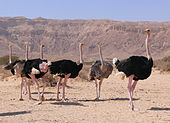 Flock of male and female ostriches in Yotvata Hai-Bar Nature Reserve, Israel. In this reserve ostriches are bred and released into the wild.
Flock of male and female ostriches in Yotvata Hai-Bar Nature Reserve, Israel. In this reserve ostriches are bred and released into the wild.
In Roman times, there was a demand for Ostriches to use in venatio games or cooking. They have been hunted and farmed for their feathers, which at various times have been popular for ornamentation in fashionable clothing (such as hats during the 19th century). Their skins are valued for their leather. In the 18th century they were almost hunted to extinction; farming for feathers began in the 19th century. The market for feathers collapsed after World War I, but commercial farming for feathers and later for skins became widespread during the 1970s. Ostriches are so adaptable that they can be farmed in climates ranging from South Africa to Alaska.
It is claimed that Ostriches produce the strongest commercial leather.[46] Ostrich meat tastes similar to lean beef and is low in fat and cholesterol, as well as high in calcium, protein and iron.[47] Uncooked, it is dark red or cherry red, a little darker than beef.[47]
Attacks
Ostriches typically avoid humans in the wild, since they correctly assess humans as potential predators, and, if approached, often run away. However, Ostriches may turn aggressive rather than run when threatened, especially when cornered, and may also attack when they feel they need to defend their offspring or territories. Similar behaviors are noted in captive or domesticated ostriches, which retain the same natural instincts and can occasionally respond aggressively to stress. When attacking a person, ostriches kick with their powerful feet, armed with long claws, which are capable of disemboweling or killing a person with a single blow. In one study of Ostrich attacks, it was estimated that two to three attacks that result in serious injury or death occur each year in the area of Oudtshoorn, South Africa.[48]
Racing
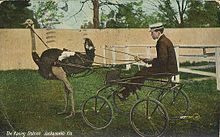 A Jacksonville, Florida, man with an Ostrich-drawn cart, circa 1911
A Jacksonville, Florida, man with an Ostrich-drawn cart, circa 1911 Ostrich running
Ostrich running See also: List of racing forms#Animal racing
See also: List of racing forms#Animal racingIn some countries, people race each other on the back of Ostriches. The practice is common in Africa[49] and is relatively unusual elsewhere.[50] The Ostriches are ridden in the same way as horses with special saddles, reins, and bits. However, they are harder to manage than horses.[51]
The racing is also a part of modern South African culture.[52] Within the United States, a tourist attraction in Jacksonville, Florida called 'The Ostrich Farm' opened up in 1892; it and its races became one of the most famous early attractions in the history of Florida.[53]
In the United States, Chandler, Arizona hosts the annual 'Ostrich Festival' which features ostrich races.[54][55] Racing has also occurred at many other locations such as Virginia City in Nevada, Canterbury Park in Minnesota,[56] Prairie Meadows in Iowa, and Ellis Park in Kentucky.[57]
Conservation
The wild Ostrich population has declined drastically in the last 200 years, with most surviving birds in reserves or on farms.[8] However, its range remains very large, leading the IUCN and BirdLife International to treat it as a species of Least Concern.[1][58] Of its 5 subspecies, the Middle Eastern Ostrich (S. c. syriacus) became extinct around 1966, and the North African Ostrich (S. c. camelus) has declined to the point where it now is included on CITES Appendix I and some treat it as Critically Endangered.[23][24][25]
See also
Footnotes
- ^ a b BirdLife International (2010)(b)
- ^ a b c d e f Brands, S. (2008)
- ^ Doherty, James G. (1974)
- ^ trails.com
- ^ "Ostrich Leather". British Domesticated Ostrich Association. http://www.ostrich.org.uk/products/leather.html. Retrieved 1 March 2011.
- ^ "Ostrich Meat". British Domesticated Ostrich Association. http://www.ostrich.org.uk/products/meat.html. Retrieved 1 March 2011.
- ^ a b c d e Gilman, Daniel Coit; et al. (1903).
- ^ a b c d e f g h i j k l m n o p q r Davies, S. J. J. F. (2003)
- ^ a b c d e Davies, S. J. J. F.& Bertram, B. C. R. (2003)
- ^ Brown, L. H., et. al (1982)
- ^ Martin, G. R. and Katzir, G (2000)
- ^ Martin, G. R., Ashash, U. and Katzir (2001)
- ^ Fleming, John (1822).
- ^ a b c d e Donegan, Keenan (2002).
- ^ a b c Nell, Leon (2003).
- ^ Brand, T. S.; Gous, R. M. (2006).
- ^ Marshall, Alan John (1960).
- ^ a b Skadhauge, E.; et al. (2003)
- ^ Linnaeus, Carolus (1758)
- ^ Gotch, A. F. (1995)
- ^ Stöcker, Friedrich W.; Dietrich, Gerhard (1995)
- ^ a b c d Clements, J. (2007)
- ^ a b Thiollay, J.M. 2006. Severe decline of large birds in the Northern Sahel of West Africa: a long-term assessment. Bird Conservation International 16: 353-365.
- ^ a b Sahara Conservation Fund: Ostrich Conservation, Niger. Accessed 16 March 2011
- ^ a b c d e f Roots, Clive (2006)
- ^ Birdlife International (2010)(a)
- ^ Freitag, Stephanie & Robinson, Terrence J. (1993)
- ^ Bezuidenhout, Cornelius Carlos (1999)
- ^ Fuller, Errol (2000)
- ^ Bibi, Faysal; et al. (2006)
- ^ Desert USA (1996)
- ^ Halcombe, John Joseph (1872)
- ^ Canadian Museum of Nature (2010)
- ^ Kruszelnicki, Karl (2006)
- ^ Maclean, Gordon Lindsay (1996)
- ^ Harrison, C. (1993)
- ^ Hyde, Kenneth (2004)
- ^ Trails.com (1999)
- ^ theanimalfiles.com
- ^ wildwatch.com
- ^ animals.nationalgeographic.com
- ^ BBC News (2003)
- ^ Texier, P. J.; et al. (2010).
- ^ Thompson, Dorothy Burr (1955)
- ^ Laufer, B. (1926)
- ^ Best, Brendan (2003)
- ^ a b Canadian Ostrich Association (2008)
- ^ Wood, Gerald (1983). The Guinness Book of Animal Facts & Feats. Sterling Publishing Co. ISBN 978-0-8511-2235-9.
- ^ Bradley, John H. (2009)
- ^ Palosaari, Ben (2008)
- ^ Mechanix Illustrated (1929)
- ^ Pyke, M. (1985)
- ^ Clark, J. C. (2000)
- ^ azcentral.com
- ^ Hedding, J. (2008)
- ^ Fluker, M. (2007)
- ^ Ethridge, Tim (2009)
- ^ BirdLife International (2010)
References
- BBC News (Mar 2003). "Ostriches "Flirt With Farmers"". http://news.bbc.co.uk/1/hi/scotland/2834025.stm.
- Best, Brendan (2003). "Ostrich Facts". The New Zealand Ostrich Association. Archived from the original on 2007-10-17. http://web.archive.org/web/20050208083829/Ostrich-association.co.nz/index.cfm/Facts.
- Bezuidenhout, Cornelius Carlos (1999). "Studies of the population structure and genetic diversity of domesticated and ‘wild’ Ostriches (Struthio camelus)". PhD thesis.
- Bibi, Faysal; Shabel, Alan B.; Kraatz, Brian P.; Stidham, Thomas A. (2006). "New Fossil Ratite (Aves: Palaeognathae) Eggshell Discoveries from the Late Miocene Baynunah Foramation of the United Arab Emirates, Arabian Peninsula" (PDF). Palaeontologia Electronica 9 (1). ISSN 1094-8074. http://palaeo-electronica.org/2006_1/eggshell/eggs.pdf.
- BirdLife International (2010). "Ostrich Struthio camelus - BirdLife Species Factsheet". Data Zone. http://www.birdlife.org/datazone/species/index.html?action=SpcHTMDetails.asp&sid=1&m=0. Retrieved 17 Feb 2011.
- BirdLife International (2010(a)). "The BirdLife checklist of the birds of the world, with conservation status and taxonomic sources." (xls). http://www.birdlife.info/im/species/Checklist_v3_June10.zip. Retrieved 17 Feb 2011.
- BirdLife International (2010(b)). "Struthio camelus". IUCN Red List of Threatened Species. Version 3.1. International Union for Conservation of Nature. http://www.iucnredlist.org/apps/redlist/details/141085. Retrieved 17 Feb 2011. Database entry includes justification for why this species is of least concern.
- Bradley, John H. (June 2009). "Riding and racing Ostriches in Oudtshoorn, South Africa". Cape Town to Cairo Website. CapeTowntoCairo.com. http://www.capetowntocairo.com/travelogue/riding-and-racing-ostriches-in-oudtshoorn-south-africa.htm. Retrieved 2009-11-10.
- Brand, T. S.; Gous, R. M. (2006). "Feeding Ostriches". In Bels, Vincent L.. Feeding in Domestic Vertebrates. Wallingford, UK: Cabi Publishing. pp. 136–155. ISBN 1845930630. http://books.google.com/books?id=2pjkMUEhScAC&pg=PA1#v=onepage&q&f=false.
- Brands, Sheila (August 14, 2008). "Systema Naturae 2000 / Classification, Genus Struthio". Project: The Taxonomicon. http://www.taxonomy.nl/Main/Classification/51244.htm. Retrieved 2009-02-04.
- Brown, L. H.; Urban, E.K.; Newman, K. (1982). "Ostriches and to Birds of Prey". In Curry-Lindahl, Kai. The Birds of Africa. I. London, UK: Academic Press. pp. 32–37. ISBN 9780121373016.
- Canadian Museum of Nature (Dec 2010). "Ostrich". Natural History Notebooks. Canadian Museum of Nature.. http://nature.ca/notebooks/english/ostrich.htm. Retrieved Feb 17 2011.
- Canadian Ostrich Association (Apr 2008). "Cooking Tips". http://www.ostrich.ca/cooking/index.htm. Retrieved Feb 17 2011.
- Clark, James C. (2000). 200 Quick Looks at Florida History. Sarasota, FL: Pineapple Press, Inc.. pp. 86–87. ISBN 1561642002.
- Clements, James (2007). The Clements Checklist of the Birds of the World (6th ed.). Ithaca, NY: Cornell University Press. ISBN 978 0 8014 4501 9.
- Cooper, J. C. (1992). Symbolic and Mythological Animals. New York, NY: Harpercollins. pp. 170–171. ISBN 1-85538-118-4.
- Davies, S.J.J.F. (2003). "Birds I Tinamous and Ratites to Hoatzins". In Hutchins, Michael. Grzimek's Animal Life Encyclopedia. 8 (2 ed.). Farmington Hills, MI: Gale Group. pp. 99–101. ISBN 0 7876 5784 0.
- Davies, S. J. J. F.; Bertram, B. C. R. (2003). "Ostrich". In Perrins, Christopher. Firefly Encyclopedia of Birds. Buffalo, NY: Firefly Books, Ltd.. pp. 34–37. ISBN 1-55297-777-3.
- Desert USA (1996). "Ostrich". Digital West Media. http://www.desertusa.com/animals/ostrich.html. Retrieved Feb 17 2011.
- Doherty, James G. (Mar 1974). Natural History (The American Museum of Natural History).
- Donegan, Keenan (2002). "Struthio camelus". Animal Diversity Web. University of Michigan Museum of Zoology. http://animaldiversity.ummz.umich.edu/site/accounts/information/Struthio_camelus.html. Retrieved Feb 17 2011.
- Ethridge, Tim (July 18, 2009). "King of the Roxy seeks another crown at Ellis". Evansville Courier & Press. http://www.courierpress.com/news/2009/jul/18/king-of-the-roxy-seeks-another-crown-at-ellis/. Retrieved July 30, 2009.
- Fleming, John (1822). Canterbury brings the Middle East to the Midwest. 2. Edinburgh, UK: Archibald Constable & Co.. p. 258. http://www.letsgosouthwest.com/canterbury-brings-middle-east-midwest.
- Fluker, Meryn (July 2007). "Canterbury brings the Middle East to the Midwest". Southwest Newspapers. http://www.letsgosouthwest.com/canterbury-brings-middle-east-midwest. Retrieved July 30, 2009.
- Freitag, Stefanie; Robinson, Terence J. (1993). "Phylogeographic patterns in mitochondrial DNA of the Ostrich (Struthio camelus)" (PDF). Auk 110 (3): 614–622. http://elibrary.unm.edu/sora/Auk/v110n03/p0614-p0622.pdf. Retrieved Feb 17 2011.
- Folch, A. (1992). "Family Struthionidae (Ostrich)". In del Hoya, Josep; Sargatal, Jordi. Handbook of the Birds of the World. 1, Ostrich to Ducks. Barcelona: Lynx Edicions. pp. 76–83. ISBN 84-87334-09-1.
- Fuller, Errol (2001) [1987]. Bunney, Sarah. ed. Extinct Birds (2nd ed.). Ithaca, NY: Cornell University Press. ISBN 0-19-850837-9.
- Gilman, Daniel Coit; Peck, Harry Thurston; Colby, Frank Moore, eds (1903). "Ostrich". The New International Encyclopædia. XIII. New York, NY: Dodd, Mead and Company. pp. 497–498. http://books.google.com/books?id=m5UMAAAAYAAJ&pg=PA497&dq. Retrieved Feb 17, 2011.
- Gotch, A.F. (1995) [1979]. "Ostriches". Latin Names Explained. A Guide to the Scientific Classifications of Reptiles, Birds & Mammals. London: Facts on File. p. 176. ISBN 0 8160 3377 3.
- Halcombe, John Joseph (1872). Halcombe, John Joseph. ed. Mission life. 3 Part 1. W. Wells Gardner. p. 304. http://books.google.com/books?id=nkEEAAAAQAAJ&dq=Ostrich+%2B+kick.
- Harrison, C.; Greensmith, A. (1993). Bunting, E.. ed. Birds of the World. New York, NY: Dorling Kindersley. p. 39. ISBN 1 56458 295 7.
- Hedding, Judy (2008). "Ostrich Festival". About.com. http://phoenix.about.com/od/arizonapicturesandphotos/ig/Ostrich-Festival/Ostrich-Festival-17.htm. Retrieved July 30, 2009.
- Hyde, Kenneth (2004). Zoology: An Inside View of Animals (3rd ed.). Dubuque, IA: Kendall Hunt Publishing. p. 475. ISBN 0757501702.
- Kruszelnicki, Karl (Nov 2006). "Ostrich head in sand". ABC Science: In Depth. Australian Broadcast Company. http://www.abc.net.au/science/articles/2006/11/02/1777947.htm. Retrieved Feb 18, 2011.
- Laufer, B. (1926). "Ostrich Eggshell Cups of Mesopotamia and the Ostrich in Ancient and Modern Times". Anthropology Leaflet (Chicago, IL: Chicago Field Museum of Natural History,) 23. http://www.worldcat.org/wcpa/oclc/468451411?page=frame&url=http%3A%2F%2Fwww.archive.org%2Fdetails%2Fostricheggshellc24lauf%26checksum%3D41180ce6855d2a53e1b3dfe7d151797b&title=&linktype=digitalObject&detail=.
- Linnaeus, Carolus (1758) (in latin). Systema naturae per regna tria naturae, secundum classes, ordines, genera, species, cum characteribus, differentiis, synonymis, locis. Tomus I. Editio decima, reformata. p. 155.
- Maclean, Gordon Lindsay (1996). Ecophysiology of Desert Birds. Berlin: Springer-Verlag. p. 26. ISBN 3540592695. http://books.google.com/books?id=YvmC2sU-LqgC&dq.
- Marshall, Alan John (1960). Biology and Comparative Physiology of Birds. Academic Press. p. 446. http://books.google.com/books?id=fsE9AAAAIAAJ&q=.
- Martin, G. R.; Ashash, U.; Katzir, Gadi (2001). "Ostrich ocular optics". Brain Behavior and Evolution 58 (2): 115–120. doi:10.1159/000047265.
- Martin, G. R.; Katzir, G. (Dec 2000). "Sun Shades and Eye Size in Birds". Brain Behavior and Evolution 56 (6): 340–344. doi:10.1159/000047218.
- "'They’re Off!' Thrills of the Turf in Ostrich Racing". Mechanix Illustrated. Sep 1929. http://blog.modernmechanix.com/2008/03/03/theyre-off%E2%80%94thrills-of-the-turf-in-Ostrich-racing/. Retrieved July 30, 2009.
- Nell, Leon (2003). The Garden Route and Little Karoo. Cape Town: Struik Publishers. p. 164. ISBN 1-86872-856-0. http://books.google.com/books?id=Sjatn8zolvsC&pg=PA164..
- O'Shea, Michael Vincent; Foster, Ellsworth D.; Locke, George Herbert, eds (1918). "Ostrich". 6. Chicago, IL: The World Book, Inc. pp. 4422–4424. http://books.google.com/books?id=bHNs2i9IYDMC&pg=PA4423. Retrieved 2009-07-18.
- Palosaari, Ben (July 19, 2008). "Extreme Race Day at Canterbury Park". City Pages. http://blogs.citypages.com/sports/2008/07/extreme_race_da.php. Retrieved July 30, 2009.
- Pyke, Magnus (1985). Weird and Wonderful Science Facts. Sterling Pub Co. Inc.. p. 82. ISBN 0806962542.
- Roots, Clive (2006). Flightless Birds. Westport, CT: Greenwood Press. p. 26. ISBN 0-313-33545-1. http://books.google.com/books?id=Sb1IJYzXZhUC&dq=.
- Skadhauge, E.; Erlwanger, K. H.; Ruziwa, S. D.; Dantzer, V.; Elbrønd, V. S.; Chamunorwa, J. P. (2003). "Does the ostrich (Struthio camelus) have the electrophysiological properties and microstructure of other birds?". Comparative Biochemistry and Physiology - Part A: Molecular & Integrative Physiology 134 (4): 749–755. doi:10.1016/S1095-6433(03)00006-0.
- Stöcker, Friedrich W.; Dietrich, Gerhard, eds (1995). "Ostrich". Concise Encyclopedia Biology. Walter de Gruyter. pp. 1149. ISBN 3-11-010661-2. http://books.google.com/books?id=LorrYj5pkKYC&dq. Retrieved 2009-07-18.
- Texier, P. J.; Porraz, G.; Parkington, J.; Rigaud, J. P.; Poggenpoel, C.; Miller, C.; Tribolo, C.; Cartwright, C. et al. (2010). "A Howiesons Poort tradition of engraving ostrich eggshell containers dated to 60,000 years ago at Diepkloof Rock Shelter, South Africa" (PDF). PNAS 107 (14): 6180–6185. doi:10.1073/pnas.0913047107. PMC 2851956. PMID 20194764. http://www.pnas.org/content/early/2010/02/17/0913047107.full.pdf
- Thompson, Dorothy Burr (Jul 1955). "A Portrait of Arsinoe Philadelphos". American Journal of Archaeology 59 (3): 199–206. doi:10.2307/500319. JSTOR 500319.
- Trails.com (1999). "Amazing Bird Records". http://www.trails.com/arts/amazing-bird-records.aspx. Retrieved Feb 17, 2011.
External links
Categories:- IUCN Red List least concern species
- Domesticated birds
- Flightless birds
- Genera of birds
- Heraldic birds
- Livestock
- Ratites
- Struthio
- Birds of Africa
- Birds of Angola
- Birds of Botswana
- Birds of Chad
- Birds of Djibouti
- Birds of Eritrea
- Birds of Ethiopia
- Birds of Tunisia
- Birds of Kenya
- Birds of Mali
- Birds of Mauritania
- Birds of Namibia
- Birds of Niger
- Birds of Somalia
- Birds of Sudan
- Birds of Tanzania
- Birds of Uganda
- Birds of Zambia
- Birds of Zimbabwe
- Megafauna of Africa
- Animals described in 1758
- 'Common Ostrich (S. struthio) complex':
Wikimedia Foundation. 2010.


